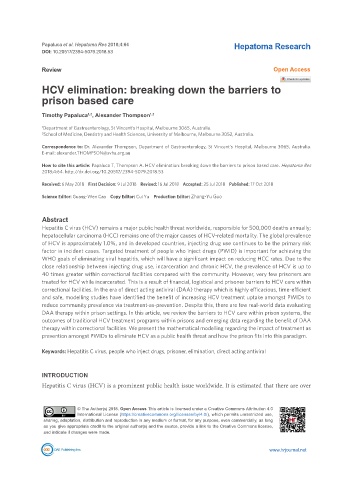Page 711 - Read Online
P. 711
Papaluca et al. Hepatoma Res 2018;4:64 Hepatoma Research
DOI: 10.20517/2394-5079.2018.53
Review Open Access
HCV elimination: breaking down the barriers to
prison based care
1,2
Timothy Papaluca , Alexander Thompson 1,2
1 Department of Gastroenterology, St Vincent’s Hospital, Melbourne 3065, Australia.
2 School of Medicine, Dentistry and Health Sciences, University of Melbourne, Melbourne 3052, Australia.
Correspondence to: Dr. Alexander Thompson, Department of Gastroenterology, St Vincent’s Hospital, Melbourne 3065, Australia.
E-mail: alexander.THOMPSON@svha.org.au
How to cite this article: Papaluca T, Thompson A. HCV elimination: breaking down the barriers to prison based care. Hepatoma Res
2018;4:64. http://dx.doi.org/10.20517/2394-5079.2018.53
Received: 6 May 2018 First Decision: 9 Jul 2018 Revised: 16 Jul 2018 Accepted: 25 Jul 2018 Published: 17 Oct 2018
Science Editor: Guang-Wen Cao Copy Editor: Cui Yu Production Editor: Zhong-Yu Guo
Abstract
Hepatitis C virus (HCV) remains a major public health threat worldwide, responsible for 500,000 deaths annually;
hepatocellular carcinoma (HCC) remains one of the major causes of HCV-related mortality. The global prevalence
of HCV is approximately 1.0%, and in developed countries, injecting drug use continues to be the primary risk
factor in incident cases. Targeted treatment of people who inject drugs (PWID) is important for achieving the
WHO goals of eliminating viral hepatitis, which will have a significant impact on reducing HCC rates. Due to the
close relationship between injecting drug use, incarceration and chronic HCV, the prevalence of HCV is up to
40 times greater within correctional facilities compared with the community. However, very few prisoners are
treated for HCV while incarcerated. This is a result of financial, logistical and prisoner barriers to HCV care within
correctional facilities. In the era of direct acting antiviral (DAA) therapy which is highly efficacious, time-efficient
and safe, modelling studies have identified the benefit of increasing HCV treatment uptake amongst PWIDs to
reduce community prevalence via treatment-as-prevention. Despite this, there are few real-world data evaluating
DAA therapy within prison settings. In this article, we review the barriers to HCV care within prison systems, the
outcomes of traditional HCV treatment programs within prisons and emerging data regarding the benefit of DAA
therapy within correctional facilities. We present the mathematical modelling regarding the impact of treatment as
prevention amongst PWIDs to eliminate HCV as a public health threat and how the prison fits into this paradigm.
Keywords: Hepatitis C virus, people who inject drugs, prisoner, elimination, direct acting antiviral
INTRODUCTION
Hepatitis C virus (HCV) is a prominent public health issue worldwide. It is estimated that there are over
© The Author(s) 2018. Open Access This article is licensed under a Creative Commons Attribution 4.0
International License (https://creativecommons.org/licenses/by/4.0/), which permits unrestricted use,
sharing, adaptation, distribution and reproduction in any medium or format, for any purpose, even commercially, as long
as you give appropriate credit to the original author(s) and the source, provide a link to the Creative Commons license,
and indicate if changes were made.
www.hrjournal.net

